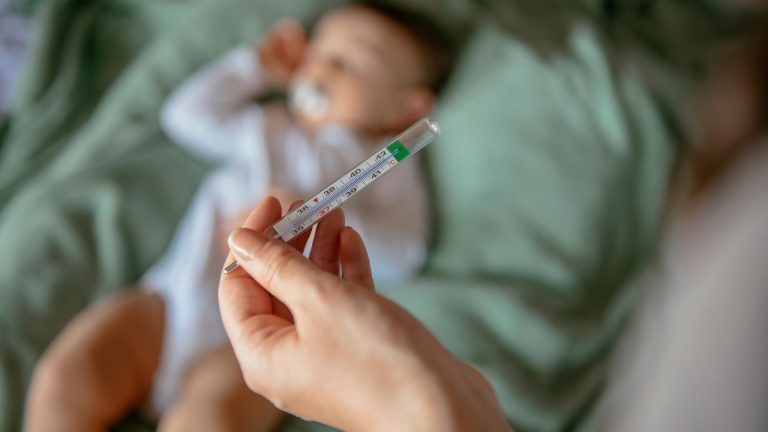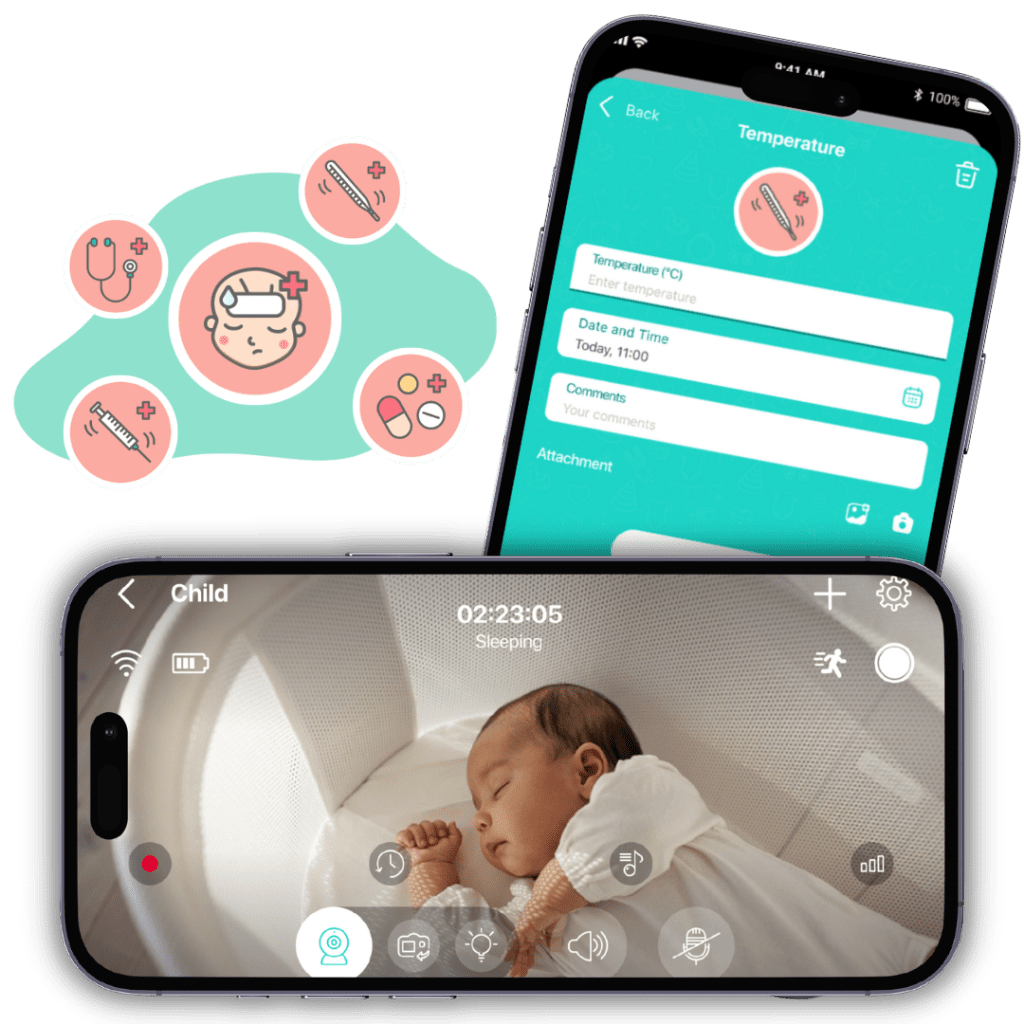
Dressing Your Baby with a Fever at Night: Dos and Don’ts
- Created:
21. 3. 2023 - Updated:
12. 10. 2023
Get this:
While most baby fevers are harmless and should disappear in a few days, some persist for weeks.
So, if your baby has such a fever, extra care and attention, especially when feeding and dressing, counts for something.
To this end:
We’ve explored the dos and don’ts of dressing your baby at night when it’s down with a fever.
How to Dress Your Baby with a Fever at Night
Keeping your baby comfortable at night during a fever can be tricky sometimes due to fluctuations in body temperature. However, a combination of lukewarm baths, lightweight clothing, and the appropriate medication would help your child get better quickly.
General Information About Baby Fevers
Here’s the thing:
In infants, fevers are usually perceived as the body’s defense mechanism and immune response to infections and diseases.
That is, it is not an actual disease but a symptom of a disease.
Note that:
One prominent sign of a fever is a high body temperature.
And a body temperature of 100.4°F or greater in children can trigger a febrile seizure.
You see:
The American Academy of Pediatrics has classified febrile seizures as either simple or complex.
Simple febrile seizures last below 15 minutes without recurrence within 24 hours, while complex seizures extend beyond 15 minutes with recurrence.
In any case:
Signs of a fever include shivering, sweating, body aches, loss of comfort, irritability, and a general display of weakness.
What to Do When Your Baby Has a Fever at Night
Now:
How do you immediately manage the situation when your child has a fever at night?
Here are a few first-aid tips for managing a fever occurrence with your toddler.
1. Take the Temperature
First off:
When your baby has a fever, you must take its oral or rectal temperature immediately.
It’s not enough to gauge their temperature by feeling their skin with your hand.
Moreover:
According to a study from the Department of Pediatrics, University of Cambridge, taking a rectal temperature in infants is safer and more accurate.
If you didn’t already know, taking your baby’s rectal temperature involves placing a thermometer in its anus.
So:
If your baby’s temperature reads 100.4°F or more, it likely has a fever.
Since fevers come with temperature fluctuations at intervals, you must monitor your baby’s temperature regularly throughout the night.
2. Take off Excess Clothing
Here’s the thing:
Due to temperature fluctuations, you may need to adjust your baby’s dressing at intervals depending on the temperature.
However, the general rule is to remove excessive clothing and dress infants in light clothing.
In addition:
Some mothers wear damp socks on their baby when it has a fever as this helps to reduce body temperature.
On the other hand, you can use a light blanket or swaddle wrap to keep your baby warm.
But:
Ensure the blanket is soft and doesn’t cover your baby’s face.
You want to avoid overheating, difficulty breathing, and other common problems associated with excessive clothing.
3. Keep Your Baby Hydrated
As you know:
Babies need a lot of fluids to stay hydrated.
So, when treating your baby’s fever, give them enough water, breast milk, or baby formula.
Also:
If your baby shows signs of dehydration, you can administer an oral rehydration solution before introducing other fluids.
4. Lukewarm Baths
Know this:
Giving your baby a lukewarm bath can help reduce their fever by a few degrees.
Keep the water warm and comfortable, and avoid applying alcohol-based cosmetics on your baby’s skin.
What to Avoid When Your Baby Has a Fever at Night
Now:
Here are a few things to refrain from doing while helping your baby get through a fever:
- Avoid giving your baby caffeinated drinks.
- Do not swaddle your child with thick blankets or extra clothes, as overdressing could elevate the body temperature.
- While Acetaminophen is sure to help lower fever in children, do not administer it unless prescribed by a doctor.
When to Call a Doctor
You see:
Fevers in infants are generally harmless, but some situations require a doctor’s attention.
Below are some of them:
- Consult a pediatrician immediately if your three-month-old baby begins to experience a fever.
- Call a pediatrician for children under 3 to 12 months old with a fever of 102.2°F (39°C) or higher.
- Inform a pediatrician if your child, aged two or less, has a fever that lasts longer than two days.
- You need to contact a pediatrician if your child has a fever accompanied by constant crying, dyspnea (shortness of breath), or bruises.
- Call a doctor if you still notice signs of inactivity or discomfort in your child after their fever goes down.
- Call your doctor if your child’s fever symptoms persist for a week.
Should You Take Clothes Off Your Feverish Infant?
Note:
Taking all clothes off your baby with a fever is not advisable.
Why? Your baby might get cold and begin to shiver.
However:
A good rule of thumb is to remove extra clothing and clothe your child in a onesie or sleep sack.
The Appropriate Room Temperature for a Feverish Baby
Listen:
Turning up the thermostat too high in a bid to prevent a cold could cause discomfort or worsen your baby’s fever.
Your child’s room temperature should not be too hot or too cool.
In line with that:
You should keep the temperature of your infant’s room within a 70°F to 74°F range.
Final Tip: Monitoring Your Baby’s Nighttime Fever with Annie Baby Monitor’s Health Tracker
If your baby is feeling feverish and you’re worried about how to dress them during the night, don’t worry. Just use Annie Baby Monitor’s health tracker for extra peace of mind.
Activate the health tracker to track the baby’s body temperature. You can set up temperature-track alerts and closely monitor any changes throughout the night.
Get the Annie Baby Monitor and become a health pro! This handy device makes organizing your baby’s feeding routine a breeze.
Final Tip: Monitoring Your Baby’s Nighttime Fever with Annie Baby Monitor’s Health Tracker
If your baby is feeling feverish and you’re worried about how to dress them during the night, don’t worry. Just use Annie Baby Monitor’s health tracker for extra peace of mind.
Activate the health tracker to track the baby’s body temperature. You can set up temperature-track alerts and closely monitor any changes throughout the night.
Get the Annie Baby Monitor and become a health pro! This handy device makes organizing your baby’s feeding routine a breeze.
Final Tip: Monitoring Your Baby’s Nighttime Fever with Annie Baby Monitor’s Health Tracker
If your baby is feeling feverish and you’re worried about how to dress them during the night, don’t worry. Just use Annie Baby Monitor’s health tracker for extra peace of mind.
Activate the health tracker to track the baby’s body temperature. You can set up temperature-track alerts and closely monitor any changes throughout the night.

Get the Annie Baby Monitor and become a health pro!
Conclusion
All in all:
You should know that baby fever is the body’s way of fighting infections and is not always harmful.
In addition, your baby’s dressing and other factors matter when treating a fever.
As such:
Here are some key points to remember:
- Dress your child in lightweight clothing and keep the room temperature moderate.
- Monitor your baby’s temperature regularly.
- Ensure your baby’s doctor prescribes medication in their appropriate dosages before administering them.
- Keep your baby comfortable at all times.
- Call a pediatrician as soon as you have any concerns or if the fever persists for weeks.
Finally:
If you still have questions regarding dressing your baby with a fever at night, please let us know in the comment section below.
Frequently Asked Questions About Dressing a Baby With Fever at Night
A lukewarm bath does the trick. However, you can also cover your child’s feet with a damp sock and swaddle them in a soft blanket.
No, do not completely undress a baby with a fever. Instead, remove extra layers of clothing until the baby is lightly clothed.






